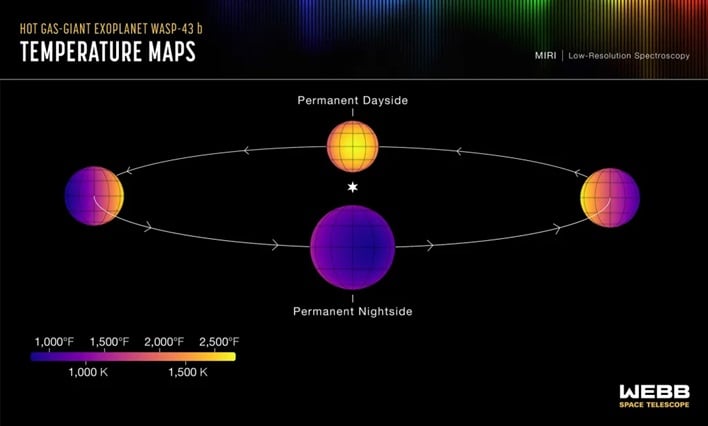JWST Spots Planet With Temps Hot Enough To Melt Lead And Blustering 5000 MPH Winds

While the exoplanet’s star is smaller and cooler than Earth’s Sun, WASP-43 b orbits at a distance of just 1.3 million miles, which is less than 1/25th of the distance between the Sun and Mercury. This means that the exoplanet is tidally locked, or that one side is continuously illuminated, while the other side is in permanent darkness. NASA says that even though the dark side of WASP-43 b never sees sunlight, the strong eastward winds transport heat around from the dayside.
“With Hubble, we could clearly see that there is water vapor on the dayside. Both Hubble and Spitzer suggested there might be clouds on the nightside,” explained Taylor Bell, researcher from the Bay Area Environmental Research Institute and lead author of a study published in Nature Astronomy. “But we needed more precise measurements from Webb to really begin mapping the temperature, cloud cover, winds, and more detailed atmospheric composition all the way around the planet.”

The researchers used precise brightness measurements over a broad spectrum of mid-infrared light, combined with 3D climate models and previous observations from other telescopes in order to suggest the presence of thick, high clouds covering the nightside of the exoplanet. It also predicted clear skies on the dayside, with equatorial winds whipping about at speeds upward of 5,000 miles per hour mixing atmospheric gases around WASP-43 b. That's fast enough to knock the hat off your head for sure.
Phase curve spectroscopy, the technique used by the researchers, involves measuring tiny changes in brightness of the star-planet system as the planet orbits the star. The amount of mid-infrared light emitted by an object using this technique depends greatly on how hot it is, according to NASA. The brightness data Webb captured was then used to calculate WASP-43 b’s temperature. WASP-43 b’s average temperature on the dayside is estimated to be nearly 23,000 degrees Fahrenheit (1,2500 degrees Celsius), or hot enough to forge iron, while the nightside sees a cooler temperature of around 1,100 degrees Fahrenheit (600 degrees Celsius).
The team was able to observe WASP-43 b with Webb’s MIRI (Mid-Infrared Instrument) every 10 seconds for 24 hours. Bell explained, “By observing over an entire orbit, we were able to calculate the temperature of different sides of the planet as they rotate into view. From that, we could construct a rough map of temperature across the planet.”
“With the new observing power of JWST, WASP-43b has been unveiled in unprecedented detail,” team member Laura Kreidberg, Director at the Max Planck Institute for Astronomy (MPIA), remarked. “We see a complex, inhospitable world, with furious winds, massive temperature changes and patchy clouds likely made of rock droplets.”
As Michael Roman, a co-author of the recent paper on WASP-43 b, remarked, “The fact that we can map temperature in this way is a real testament to Webb’s sensitivity and stability.”

